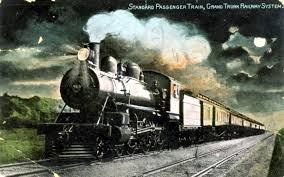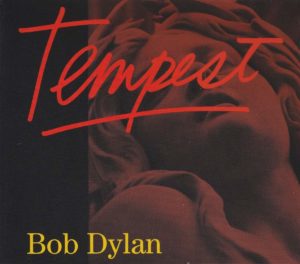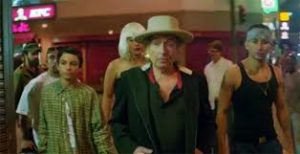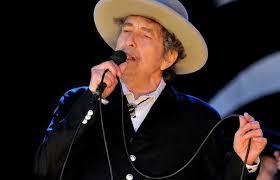BOB DYLAN: DUQUESNE WHISTLE
You’re the only thing alive that keeps me going
You’re like a time-bomb in my heart…”

In Tempest Bob Dylan takes us on a ‘dream journey’ through storms and bitterness and rage. The dream visions increase in intensity, as he draws us into a parallel vision of ‘modern times’ in which the ghosts of the past mingle with the living. The songs become more bitter as the ‘death count gets higher’, until we are shown an apocalyptic vision of a world that is drowning as its guardians dream on. Finally, we go even beyond death itself… Tempest represents the culmination and triumphant climax of the poetic and musical methods Dylan had been developing in Love And Theft and Modern Times, albums full of narrators who seem to live in a world where time has stopped, where ‘the future is always a thing of the past’. This world is a poetic construction in which snatches of the voices from the past, particularly those of the great blues and country singers and the great visionary poets, intermingle. The music which carries this vision is rooted in the pre rock and roll era of the 1920s to the 1950s, yet it is informed, like the poetry, by a very modern consciousness. By deliberately ‘quoting’ from so many sources in the songs on these albums, Dylan has had to face many accusers (as he has had to so many times in the past, especially in 1965-66 when he ‘went electric’ and 1979-80 when he ‘went religious’). Some unsympathetic critics seem to think that such ‘quotation’ from so many sources is the result of Dylan running out of inspiration and so having to plagiarise the work of others.
The cry is the same as in 65 and 79 – why can’t he be like he used to be? Yet the way of creating songs Dylan has developed over the past decade or so gives his art an immense richness. It is as if the spirits of Ovid, Blake and Shakespeare and of Muddy Waters, Robert Johnson, Hank Williams and Johnny Cash (and many, many others) actually live within these songs. These are songs which somehow ‘contain’ and ‘embody’ all the work of the past that they celebrate, yet which combine that work in a distinctively post modern framework. Just as Dylan’s songs in ‘60s reflected first the political and later the psychic consciousness of the first era of ‘global village’ media consciousness, so his contemporary work reflects a world in which that consciousness is no longer represented in any kind of ‘youth movement’ but has become fractured, disparate, as if we are now listening to millions of voices shouting at us at once. This consciousness is represented most clearly in the ‘digital universe’ in which we increasingly live, a world in which the products of the present and the past intermingle in a seamless flow. Most popular music has become largely irrelevant, a kind of mindless, ever-repeating muzak. So Dylan, in order to remain contemporary and not a mere relic of the past, has reinvented his art by reaching out to the past, embracing the music of the past in order to make music that expresses the true spirit of today’s world.

Duquesne Whistle begins with a charming little vignette of a tune, a delicate, jaunty 40 second 1920s ragtime mini-overture played by Dylan, Charlie Sexton and Stu Kimball on electric guitars, set against acoustic strumming. The tune is rather evocative of Tom Paxton’s famous ballad The Last Thing On My Mind, itself derived from the traditional The Leaving of Liverpool, which the young Dylan first heard the Clancy Brothers sing and turned into his own Farewell. Their narrators of these wistful odes to impotence can only cry into their beer as they sail away to some distant shore, leaving their loved ones behind. And here the musicians sound far away, stranded in time as well as space. Past and present are juxtaposed starkly, as they will be throughout the album, as suddenly the amplified drums and bass explode into action and a furious swing rhythm kicks in, as if an express train has just rounded a sharp corner and is heading full tilt towards us. Meanwhile, the country blues strummers, sitting by the train track in their overalls, are drowned out. And… lo and behold! Here is ol’ Uncle Bob, in the uniform of the conductor, holding his whistle aloft, with a lascivious smile and a peculiar twinkle in his eye, sounding for all the world like Louis Armstrong, inviting us into a world of storms – of lust and greed and revenge and murder, which will end in cataclysm. As with Modern Times and Love And Theft the songs seem to exist in a mythical Americana of the past, a kind of ‘ship of state’ battered by hurricanes on all sides. But while most of the songs on those albums were upbeat, like Summer Days or Thunder On The Mountain, or wistfully reflective, like Sugar Baby or When The Deal Goes Down, here we are in darker territory. A major ‘tempest’ is brewing. And Dylan stands in the eye of the storm, transformed into a different kind of ‘conductor’. Like Prospero, he weaves and manipulates the magic around him. Such stuff that dreams are made on. … But right now, there’s a train rushing towards us, and we are being urged to jump on board.

The symbolic presence of the train is at the heart of the mythology of Americana. It was the laying of train lines that made possible the conquest of the West, and thus of the uniting of the continental USA. Yet in modern America the importance of trains is much diminished. In the second half of the twentieth century, they were superseded by the highways as major carriers of freight and people. So trains now tend evoke a nostalgia for that older America, in which much of the imagery and musical architecture of Dylan’s 21st century work is located. The train is, of course, is one of the key metaphorical tropes of blues imagery. For southern blacks it represented both freedom and escape, and trains make their appearance in countless blues songs. …When the whistle blows I gotta go, oh mama don’t you know… begins the refrain of Freight Train Blues, the much-recorded blues classic originally written by John Lair in 1935 and covered by Bob Dylan on his debut album in 1962. Dylan’s version, like many of its antecedents, incorporates the rhythm of the train into the musical performance. The rhythm is fast and the vocal delivery manic, and both are as exaggerated as the playfully self deprecating nature of the song itself, whose narrator was ‘born by a railroad track’ and for whom …the holler of the driver was my lullaby… Here the train represents the high spirited determination of its narrator not to be held back or slowed down. Turning such sentiments around, in his iconic Folsom Prison Blues (1955) Johnny Cash’s ‘tortured’ (and very probably condemned) narrator sits in his cell, listening to the trains go by and imagining that …there’s rich folks eatin’, In a fancy dining car, They’re probably drinkin’ coffee, And smokin’ big cigars. For this inmate, of course, there will be no escape. Trains (with their undeniably phallic qualities) can also function as sexual metaphors of various kinds. In Elvis Presley’s epochal version of Junior Parker’s Mystery Train (1955) the singer’s panting delivery imitates a train and conveys rampant sexual desire at the same time. Sex, however (like trains) can of course be slow and steady as well as fast and unrestrained. A comparison of the earlier and later versions of Dylan’s majestic It Takes A Lot To Laugh, It Takes A Train To Cry (1965) illustrates this well. The earlier versions (available on the epic new Bootleg Series’ The Cutting Edge) uses a standard ‘fast train’ rhythm, while the recorded version slows the pace, making the song’s extended sexual imagery, like … If I don’t make it, you know my baby will… and …Don’t my gal look fine when she’s coming after me… both more subtle and more sensual. While Elvis thrusts without restraint, Bob gives his ‘gal’ time to catch up. …I wanna be your lover/I don’t wanna be your boss… he sings. Trains work just fine as sexual metaphors, especially in musical poetry. You can speed them up, you can slow them down, you can make them judder and shake and stutter to a halt, whistles blowing…

What Dylan loves about blues imagery is its endless ambiguity, the way its symbolism can be twisted and turned around. In another strand of the blues tradition, trains operate as religious metaphors; such as in the traditional This Train Is Bound For Glory (memorably recorded by Sister Rosetta Tharpe in 1935 and later adapted in a more secular form by Woody Guthrie), in which the passengers on the train are speeding towards heaven; Curtis Mayfield’s gospel classic People Get Ready, first recorded with his group The Impressions in 1965 (and covered several times by Dylan) develops this metaphor further, taking the holy train on a journey of liberation that symbolises the struggle of blacks and other oppressed minorities for freedom and equality. In stark contrast, in Dylan’s angry and confused ‘gospel song’ Slow Train (1979), the ‘slow train coming’ appears to represent the inevitability of Armageddon, and of the descent of God’s judgement on the wicked. It is significant that, in a recent Rolling Stone, interview Dylan states that he intended Tempest to be a more ‘religious’ album “I wanted to make something more religious. I just didn’t have enough [religious songs]. Intentionally, specifically religious songs is what I wanted to do. That takes a lot more concentration to pull that off 10 times with the same thread – than it does with a record like I ended up with.” As he so often does in his interviews, Dylan is surely putting us on here. In fact, the inner conflicts in the songs on Tempest often depict spiritual conflicts, as the various narrators confront the nature of both happiness and despair, love and hate and the cruelty of fate. But there are no ‘trains to glory’ here. There seems to be a God who lurks behind these songs, but this is a diety which is distant, unknowable, even terrifying. A sneering, spitting, vengeful Jehovah. These are not songs of faith, but songs of inner turmoil, of spiritual wasting away, of prices paid in blood. These are songs that face squarely up to death. Yet, despite their ‘religious’ references, these songs do not (as the ‘other’ Dylan once wrote) ‘go gently into this good night’.

Duquesne Whistle softens us up for the carnage that is to come with its jokey, metaphor-laden message of personal defiance. In the blues, trains symbolize sexual potency, which in itself can also represent defiance against the prevailing social order. From Muddy Waters’ I’m A Man to James Brown’s It’s A Man’s Man’s World , blues singers have indulged in sexual boasting, just as rap artists do today. This celebration of the body in such music functions as a kind of unconscious rebellion against puritanical Christian values. It is a way in which culturally oppressed people can express their pride in themselves, so that the declaration of sexual freedom becomes a declaration of freedom itself, a refusal to accept the connection between sex and shame which was still dominant in the first half of the twentieth century, when the blues was at its peak. Later, the transformation of the blues into rock and roll did much to ignite the sexual revolution of the second half of the century, in which centuries of religious shame about sex were swept away and the body was celebrated, whether it be through Elvis’ ultra macho style, the early Beatles’ feminised orgasmic ‘oohs’, the Rolling Stones’ gloriously sexually ambiguous preening or Jimi Hendrix’s extraordinary expansion of sexual energy into the cosmos: …S’cuse me, while I kiss the sky!…. Thus, the sexual revolution was inevitably followed by a revolution in life styles and political and social world views. Right in the centre of all this was Bob Dylan himself, whose songs have always been permeated by the ethos and imagery of the blues. However, it is important to remember that within black American culture itself, the blues was never ‘respectable’. It was characterized, largely by black people themselves, as the ‘devil’s music’. The great mass of black Americans were God fearing church goers, out of which came the rich tradition of gospel music which, despite its obviously Christian lyrical expression, had a great deal in common with the blues in musical harmonic terms. Many blues singers actually alternated between performing blues and ‘spiritual’ music. This tension between the Lord’s music and the Devil’s music is also what energises much of early rock and roll. The extreme sexual expression in the music of Little Richard and Jerry Lee Lewis was made even more powerful by the double edged sense in their music that this Whole Lotta Shakin’ Goin’ On was somehow shameful. This tension was also expressed very powerfully in much of the country music of the early 1950s. The music of country singers from ‘poor white’ origins like Hank Williams and Johnny Cash was deeply informed by the spirit of the blues, but in their songs the sexual/religious tension was even more pronounced. In Hank Williams’ I Heard That Lonesome Whistle Blow (recorded by Dylan in the Freewheelin’ sessions and later performed by him in the 1990s) the narrator sits in his prison cell listening to the train whistle blow outside, revelling in his own sense of shame. As with Cash’s Folsom Prison Blues, the prison setting itself works as a kind of metaphor for the sexual and emotional repression imposed on them by conventional religion. The fact that both singers are clearly sincere in their religious beliefs only adds to the poignancy of their plight. They sincerely want to be free, but the fact that they genuinely seem to believe that they actually deserve their fate only makes the songs more painfully heartbreaking.
Duquesne Whistle is a successor in its way to these two earlier songs. Folsom Prison Blues ends with the singer telling us that if only he could be freed from his prison …I’d let that lonesome whistle blow my blues away… This in itself is a reference to the Williams song. In the second line of every verse, Dylan describes the Duquesne Whistle similarly, as a spirit of freedom, a wind that is blowing away various repressions. At first it is …blowin’ like it’s gonna sweep my world away… In the penultimate verse, the whistle is …blowin’ like it’s gonna blow my blues away… This is a direct reference to the Cash song, and thus to the Williams song before it, and to all the older blues songs that inspired both singers. Yet Duquesne Whistle is not a song of anguish. The singer is certainly not trapped in sexual repression. Far from it, in fact. The scenario is that of an older man who is pursuing a vigorous sexual relationship with a younger woman. … I wake up every morning with that woman in my bed… the narrator tells us, sounding terribly pleased with himself …everybody’s telling me she’s gone to my head… Here Dylan references both the jazz standard You Go To My Head and the archetypal blues intro…woke up this morning… (as used in Elmore James’ sly ode to masturbation Dust My Broom). Almost every line is either lifted from an old blues song or cleverly inverts established blues clichés. Dylan revels in the suggestiveness of the language. In the first verse his po-faced protestation of ‘innocence’: You say I’m a gambler/ You say I’m a pimp/ But I ain’t either one… directly echoes Big Joe Turner’s line in his Playboy Blues …Some people call me a pimp, some people call me a gambler, but I ain’t neither one… In the second verse, the narrator’s lover is ...smiling through the fence at me… which resembles a line in the traditional song Watermelon On The Vine, popularised by bluegrass legend Bill Monroe : …see that watermelon smiling through the fence… The knowing line … You old rascal, I know exactly where you’re going… echoes the song You Rascal You which was performed by Cab Calloway and later by Louis Armstrong : …When you dead in your grave, No more women will you crave, I’ll be glad when you dead, you rascal, you!… Dylan twists all these lines around, playing heavily on their suggestiveness. For good measure, there are a couple of literary allusions thrown in. The narrator’s lover is …blowin’ like she’s at my chamber door… playfully referencing Edgar Allan Poe’s The Raven (another ‘song’ which uses dark sexual metaphors) while the line …the lights of my native land are glowin’ in the final verse echoes Ovid in The Art Of Love (which Dylan declared he was ‘studying’ in Modern Times’ opening track Thunder On The Mountain).

At the beginning of each verse, the narrator implores us to listen to the ‘Duquesne whistle’. The name Duquesne (pronounced ‘doo-cain’) refers to the town of Fort Duquesne in Pennsylvania, but the song makes a direct reference to the Duquesne train route, which ran through America’s industrial heartland, from New York to Pittsburgh, from the 1930s to the 1950s. Carbondale, which is also referred to in the first verse, is another industrial town in Pennsylvania. The main reason for using these names seems to be to convey the idea that the train in the song, like the narrator, is ‘of a certain vintage’. As Dylan sings at the end of the first verse … Sounds like it’s on its final run… At the end of the second verse the train whistle is …blowin’ like it ain’t gonna blow no more… Later, more explicitly, the whistle is …blowing like it’s gonna kill me dead… On one level, the train is a metaphor for the narrator’s sexual prowess. He is an old man, and this may be his final fling, but he’s sure gonna go out with a bang, as you might say. Yet Dylan turns all this around by also identifying the train whistle with his young female lover. In the second verse, the train whistle is …blowin’ like she’s never blowed before… and so now becomes explicitly female. She appears at his ‘chamber door’ positively panting with lust: …blue light blinking, red light glowing… Using a particularly ‘Dylanesque’ technique (itself suggested by the ambiguity of patterns of reference in many old blues songs) Dylan switches his mode of address (through his use of personal pronouns) here from ‘she’ to ‘you’. Now he addresses his lover directly, identifying her clearly as the source of his sexual rejuvenation: …You’re the only thing alive that keeps me going/ You’re like a time-bomb in my heart… The suggestion seems to be that the young lover’s sexual energy may be so ‘explosive’ that it may be the end of him. This is typical of the self deprecating, almost grateful tone of the narration here, which may well be influenced by the many late period Leonard Cohen songs such as I’m Your Man in which the ageing narrator appears to be begging young women for their favours, in a way that is rather humorously seductive. The combination of voice and music here underlines this perfectly, with Dylan’s quite deliberately cracked and gravelly ‘aged’ voice contrasting against the sprightly ‘jitterbug’ dance rhythms the band is playing.
Dylan follows the reference to the ‘time bomb’ with perhaps the song’s most strikingly surprising lines: …I can hear a sweet voice gently calling/Must be the mother of our Lord… The reference to death is quite explicit here, yet in the first line we might imagine he is referring to his lover who, however, is pointedly not a virgin. The narrator’s sudden switch into a kind of jokey faux-religiosity is, however, handled with the kind of light irony that permeates the song. When Dylan sings …blowin’ like my woman’s on board… we are reassured that this sudden lapse into his ‘conscience’ has not deflected him from his lustful pursuit of the girl. This is further emphasized by the line in the next verse, which is surely the funniest line in the song: You old rascal, I know exactly where you’re going/ I’ll lead you there myself at the break of day… Here, which the narrator actually seems to be addressing his own penis! In the final verse, the line …I wonder if that old oak tree’s still standing… (itself a reference to the country standard The Green Green Grass of Home, in which the narrator’s fantasy of returning home is finally undercut by the revelation that he is in fact a condemned man waiting to be executed) is another playful sexual illusion, in which the narrator again plays the aged roué.
In Modern Times’ Spirit On The Water Dylan had deliberately teased his audience with the lines .. You think I’m over the hill, you think I’m past my prime/ Let me see what you got/ We can have a whompin’ good time… This is a line which often draws cheers from the crowd at Dylan’s live shows, allowing them to acknowledge that, despite his advancing years, Dylan is still functioning as a highly creative and challenging artist. Here, as a way of introducing us to the world of Tempest, he expands this concept into an entire song. The album contains many references to death, but its introductory song cheerfully raises a finger to death. Co-written with former Grateful Dead lyricist (as was most of the material on Together Through Life) Duquesne Whistle displays the lyrical precision and dexterity of many of the previous album’s songs, but adds a lightness of touch that is skillfully deceptive. Dylan carefully leads us astray in this way. In fact the album’s songs will successively descend into greater and greater darkness, displaying a kind of Poe-like relish in doing so. Here Dylan throws a time bomb at us, which is ready to explode. In no uncertain terms, it declares that, despite his advancing years, this artist is still cooly, articulately and often quite venomously, raging against the dying of the light.
A different version of this text appears in DETERMINED TO STAND: THE REINVENTION OF BOB DYLAN
DYLAN LINKS
DAILY DYLAN NEWS at the wonderful EXPECTING RAIN
THE BOB DYLAN PROJECT- COMPREHENSIVE LISTINGS
STILL ON THE ROAD – ALL DYLAN’S GIGS
THE CAMBRIDGE BOB DYLAN SOCIETY


Leave a Reply